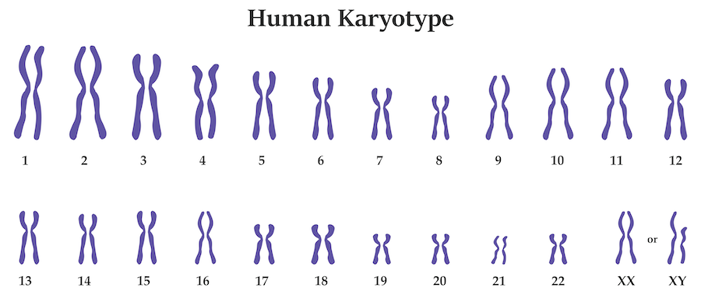
Why is the combination of red hair and brown eyes so rare?
May 18, 2007

- Related Topics:
- Hair color,
- Red hair,
- Eye color,
- Pigmentation traits
A curious adult from Texas asks:
"Why is the combination of red hair and brown eyes so rare?"
Editor’s Note (8/13/2021): While this article describes eye color as a simple trait determined by the OCA2 gene, we now know that there are over 50 different genes that affect your eye color.
No one knows for sure why this is. There isn't any evidence that the DNA changes that cause red hair also affect eye color. Or vice versa.
And the two aren't genetically linked like some other hair and eye color combinations. For example, blonde hair and blue eyes are known to be linked. Which is why blonde hair and brown eyes are so rare.
But we know this isn't the case for red hair and light colored eyes. How do we know this?
Because the DNA changes in the MC1R gene that cause red hair are on chromosome 16. And the DNA changes in the OCA2 gene that cause blue eyes are found on chromosome 15.
Genetic Linkage
Genetically linked traits need to be on the same chromosome. Like blonde hair and blue eyes which are both found on chromosome 15. This is important because of how genes are passed on to our children.
We each have 23 pairs of chromosomes that contain almost all of our genes. We pass our genes down to our children in these chromosome chunks.
So if the DNA changes for blue eyes and blonde hair happen to both be on the same copy of chromosome 15, then they will tend to travel together*. Think about it like suitcases at the airport.
Imagine you have blonde hair coloring and blue contact lenses that you are taking with you on a trip. If you have two separate suitcases, then there is a chance that one might get sent to Detroit and the other to Honolulu. Your blonde hair coloring will be in one place and your contact lenses in another.
But if you only have one suitcase, everything in it will almost always travel together. Wherever your suitcase ends up, the blonde hair dye and the blue contact lenses will arrive at the same place.
Same thing with genes on the same chromosome. The DNA changes that cause blonde hair and blue eyes are usually on the same chromosome (in the same suitcase). So they usually arrive together.

Red Hair and Light Eye Color Combination
But this explanation doesn't work for red hair and light eye color because the DNA changes that cause them are on different chromosomes. They are in different suitcases.
Most likely red hair and light colored eyes tend to be together because of luck. And the possible survival advantages of each.
Let's think back to a time before there was red hair. Imagine for some reason, the folks in Northern Europe have lighter colored eyes. This may be because their ancestors found lighter eyes more attractive (sexual selection). Or perhaps there is some other advantage (click here for some possibilities).
So we have a population in Northern Europe with light colored eyes. And everywhere else there are brown eyes.
Now imagine that a DNA change happens in Africa and in Europe that causes red hair. This wouldn't be surprising — our DNA changes all the time.
Most of the time these DNA changes don't matter. But sometimes they can cause a disease. And sometimes a DNA change can change how someone looks.
Now we have one redhead in Africa and one in Northern Europe. Perhaps the redhead in Europe is able to live a normal life, and has many children. But maybe the redhead in Africa doesn't find a partner, and never has children. So the red hair gene spreads in Europe, but not in Africa.
The end result of this is redheads with light colored eyes. Not because the genes are necessarily linked. But because the red hair happened to occur in a population with light colored eyes.
Of course we don't have any evidence for this story. But it is a plausible one because of a side effect of red hair — light skin from the MC1R gene.
We need a certain amount of sunlight to make vitamin D. If you don't get enough vitamin D you end up with rickets, an awful disease.
The darker your skin is, the more sunlight you need. Northern Europe gets so little sunlight that lighter skinned people have a real advantage. People like redheads.

In Africa, people with light skin were at a real disadvantage. The extra sunlight exposure can cause birth defects by destroying their folic acid. And they could end up riddled with skin cancer later in life since no one had invented sunscreen yet.
So in which population do you think red hair will prosper and spread? Yup, amongst those Northern Europeans with light colored eyes.
Because of this, you just happen to end up with lots of redheads with light colored eyes. This is one idea anyway.
As more mixing between populations happens, we would predict that red hair and light colored eyes will both become less common. But another prediction, if this little story I spun is true, we would predict that red hair and brown eyes would be a more common combination as more mixing between populations happens. We'll have to wait and see.
*This is a simplified version. Because of something called recombination, it is important that the DNA changes be on the same chromosome and close to each other. Click here for the details.

Author: Dr. D. Barry Starr
Barry served as The Tech Geneticist from 2002-2018. He founded Ask-a-Geneticist, answered thousands of questions submitted by people from all around the world, and oversaw and edited all articles published during his tenure. AAG is part of the Stanford at The Tech program, which brings Stanford scientists to The Tech to answer questions for this site, as well as to run science activities with visitors at The Tech Interactive in downtown San Jose.
 Skip Navigation
Skip Navigation
